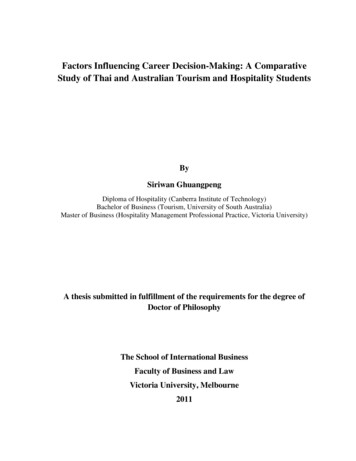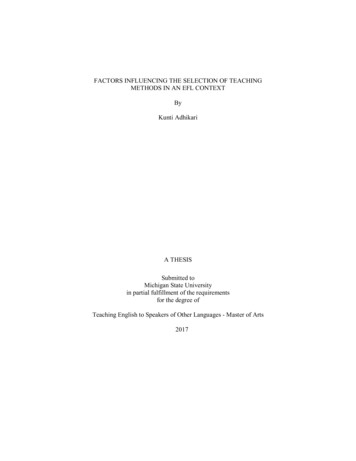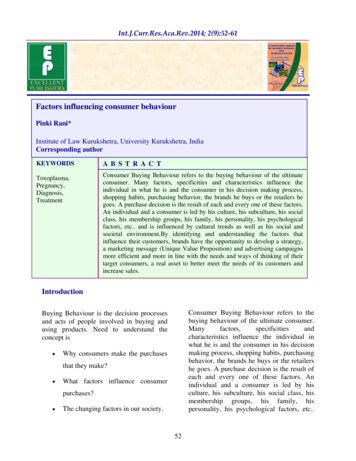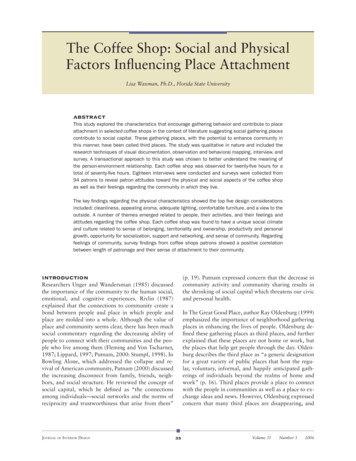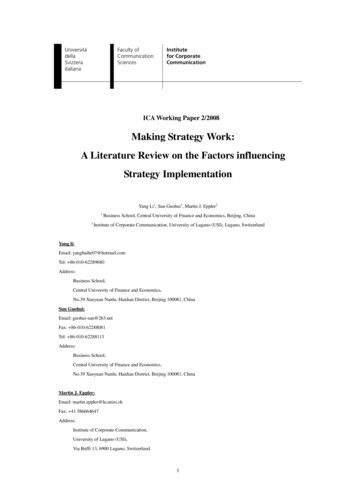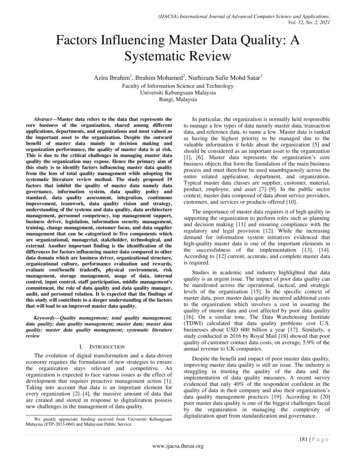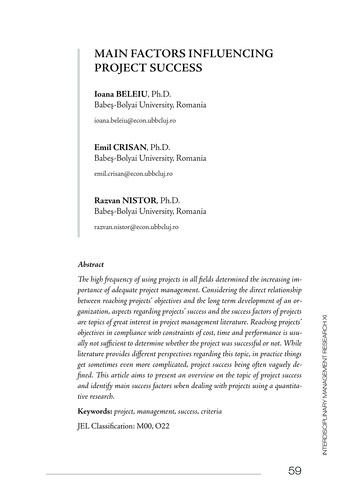
Transcription
MAIN FACTORS INFLUENCINGPROJECT SUCCESSIoana BELEIU, Ph.D.Babeș-Bolyai University, Romaniaioana.beleiu@econ.ubbcluj.roEmil CRISAN, Ph.D.Babeș-Bolyai University, Romaniaemil.crisan@econ.ubbcluj.roRazvan NISTOR, Ph.D.Babeș-Bolyai University, Romaniarazvan.nistor@econ.ubbcluj.roThe high frequency of using projects in all fields determined the increasing importance of adequate project management. Considering the direct relationshipbetween reaching projects’ objectives and the long term development of an organization, aspects regarding projects’ success and the success factors of projectsare topics of great interest in project management literature. Reaching projects’objectives in compliance with constraints of cost, time and performance is usually not sufficient to determine whether the project was successful or not. Whileliterature provides different perspectives regarding this topic, in practice thingsget sometimes even more complicated, project success being often vaguely defined. This article aims to present an overview on the topic of project successand identify main success factors when dealing with projects using a quantitative research.Keywords: project, management, success, criteriaJEL Classification: M00, O2259INTERDISCIPLINARY MANAGEMENT RESEARCH XIAbstract
1.INTRODUCTIONIoana Beleiu x Emil Crisan x Razvan Nistor: MAIN FACTORS INFLUENCING PROJECT SUCCESSProjects are used in all economic and non-economic fields as mean of organizing the activity, aiming the achievement of desired objectives. There is a direct relationship between projects, projects portfolio, programs and the organisationalstrategy. Projects, as the main way of creating and dealing with change (Cleland,Gareis, 2006), are used to implement strategies. Meskendahl (2010) refers toprojects as the central building block used in implementing strategies, thereforebusiness success is determined by the success of the projects. According to PMI(2013), aligning projects with strategic objectives brings value to an organization. Implementing successful projects generates positives effects on the organisation, influencing not just short and medium, but also long term development.The topic of business success is related to aspects of profitability and competitive advantage. Several studies have been made in this field due to the importance of finding what success is and how it is measured. In this paper wefocus on projects’ success, a topic of great interest in project management literature. Success approached in relationship with projects is even more importantsince the number of failing projects is extremely high, more than one third ofprojects failing to reach their objectives (PMI, 2013).Initially, project success was referred to as reaching the objectives andthe planned results in compliance with predetermined conditions of time, costand performance. As knowledge in project management field developed, the“golden triangle” was considered not enough to define project success. Projectsuccess was recognised to be a complex, multi-dimensional concept encompassing many attributes (Mir, Pinnington, 2014). Projects are unique, reasonwhy project success criteria differ from one project to another (Müller, Turner,2007). To increase complexity even more, within the last decades the conceptof project success is approached in relationship with stakeholders’ perception(Davis, 2014), being accepted that success means different things to differentpeople (Shenhar et al, 2001). What determines project success, referred to assuccess factors, is also approached and considered to be of great interest.Base on the importance of the topic and the challenge of reaching projectsuccess, in this paper we analyse the main aspects related to project successbased on a literature review: success criteria and success factors. Furthermore,we complement the study with an empirical research focused on the main factors of project success.60
2.THEORETICAL BACKGROUND . . P ’ A differentiation should be made between the two related concepts: successcriteria and success factors. First, relevant success criteria have to be identifiedand then, success factors should be determined in order to increase the chancesof project success (Müller, Turner, 2007). Although, in this article, we focus ourattention mostly on success factors, success criteria cannot be neglected.This increased level of complexity when approaching aspects of projects’success is normal and determined by the dynamic environment where projectsare implemented. While in project management literature the list of successcriteria is supplemented constantly with measurable or non-measurable items,in practice the situation becomes confusing, project managers having to dealwith situations of implementing projects that don’t have clearly defined successcriteria. One of the success conditions mentioned by Davis (2004), based on acomprehensive literature study, is that “success criteria should be agreed on withstakeholders before the start of the project, and repeatedly at configuration review points throughout the project”. . . P ’ Success factors can be perceived as main variables that contribute to projects’success (Dvir, 1998), as levers that can be operated by project managers to increase chances of obtaining the desired outcomes (Westerveld, 2003). A combination of factors determine the success or failure of a project and influencingthese factors at the right time makes success more probable (Savolainen, 2012).In earlier project management literature the main focus was on identifying ge-61INTERDISCIPLINARY MANAGEMENT RESEARCH XISuccess criteria are defined by Muller and Turner (2007) as variables thatmeasure project success. Since project success might be perceived differentlyby stakeholders, there is a need for comprehensive criteria that reflect their interests and views (Dvir et al., 1998). Westerveld (2003) emphasises the importance of stakeholders’ satisfaction as a main success criteria, complementaryto the golden triangle of time, budget and quality, and adds that different timelags should be considered. Establishing a set of criteria applicable to any type ofproject is unrealistic (Mir, Pinnington, 2014). Although certain criteria mightbe relevant in measuring the success of most projects, they should be adapted tosize, complexity, duration, type and stakeholders’ requirements.
Ioana Beleiu x Emil Crisan x Razvan Nistor: MAIN FACTORS INFLUENCING PROJECT SUCCESSneric factors that contribute to projects’ success. Within the last years, authorsemphasised on the existence of different success factors depending on projecttype. The struggle to identify the critical success factors is an ongoing topic,approached by many researchers especially due to the pressure of implementing successful projects in a dynamic global market and ever changing businessworld (Crisan, Borza, 2014), where continuous innovation is a must in order toachieve competitive advantage (Salanta, Popa, 2014).Davis (2014) studies project management success in literature from 1970sto present, classifying the evolution of success factors into decades. According tothis study, approaches of success factors evolved from focusing on the operationlevel of a project in 1970s to embracing a stakeholder focused approached after2000s (Davis, 2014). As a result of the numerous studies that approached thetopic of project success, several lists of success factors exist. Pinto and Slevin’spaper from 1987 represents a reference point by establishing a list of ten success factors, recognised by other authors as accurate (Turner, Müller, 2005):project mission, top management support, schedule and plans, client consultation, personnel, technical tasks, client acceptance, monitoring and feedback,communication, trouble-shooting (Pinto, Slevin, 1987). Davis (2014) adoptedin her paper a set of nine themes in order to describe success factors of projects: cooperation and communication, timing, identifying/ agreeing objectives,stakeholder satisfaction, acceptance and use of final products, cost/ budget aspects, competencies of the project manager, strategic benefits of the project andtop management support. These lists of factors mentioned above, completed byinputs from practitioners, are the basis of the empirical research presented inthis paper.Yu et al. (2005) discussed the timing of project evaluations which aim analysing the success, concluding that the process is useful at any time between the firstmilestone until the completion of the project. The results of these evaluationsmight indicate inconsistencies that can have negative influence on the final outcomes. Whenever these situations occur, project managers should act in order toincrease success chances by influencing the previously identified success factors.3.METHODOLOGYThe article complements the literature review with an empirical study onsuccess factors. The objectives of the study are to identify the main factors of62
projects’ success. By conducting the research we aim to answer the followingresearch questions:RQ1: What are the top five factors that have the highest influence on projects’ success?RQ2: What is the correlation between the factor considered to have thehighest influence on projects’ success and the other factors?The structure of the questionnaire includes a first section where respondents are asked to choose from a list of success factors five factors that have thehighest influence on projects’ success. The list of nineteen success factors presented in the questionnaire is based on previous studies of Pinto, Slevin (1987)and Davis (2014) and on inputs received from project managers. Thus, it waselaborated a comprehensive list of success factors that approaches operationaland strategic aspects, and also considers both internal and external projects’ environment. The second section of the questionnaire requests respondents to therank the statements on a Likert scale from 1 to 5 (1- strongly disagree, 2- disagree, 3- uncertain, 4- agree, 5- strongly agree), based on their experience andreflecting the situation within a project that they are currently working on. Thelast part of the questionnaire includes general identification data as: the role ofrespondents in the project, their experience in dealing with projects, the countrywhere they are located, and the type of the project they referred to.The phases of the analysis are in accordance with the structure of the questionnaire. Thus, in the first phase we analyse the factors having the highestimpact on projects’ success. The second phase of the analysis refers to specificprojects that respondents currently work on. In this phase, for the top five factors that received the highest number of votes previously, an in-depth analysisis made. Since it is generally accepted that success factors relate to each other,statistical tests are applied in order to analyse the correlation between the success factor that received the highest number of votes and all the other factors.63INTERDISCIPLINARY MANAGEMENT RESEARCH XIThe study is based on a quantitative research. Quantitative research involvesstudies that make use of statistical analyses to obtain their findings (Marczyket al, 2005). The method of data collection used is a questionnaire addressedto project managers, project team members, owners, sponsors, contractors, clients or other interested parties involved in projects’ implementation. The severalroles targeted aimed capturing a comprehensive overview of the approachedtopics.
The number of responses received within a month of applying the questionnaire is 47. Although this number might be seen as a limit of the quantitativeresearch, a higher number of responses being needed for accurate generalisationof the results, the study can be perceived as a pilot study that provides usefulinformation and directions for future research.Ioana Beleiu x Emil Crisan x Razvan Nistor: MAIN FACTORS INFLUENCING PROJECT SUCCESSThe respondents answering the questionnaire are mostly project managers (51%) and project team members (38%), with an experience in managingprojects of 2 to 5 years (47%) and of 6 to 10 years (28%), working in Romania (80,9%), Austria (8,5%), China (4,3%), France (2,1%), Israel (2,1%) andUnited Arab Emirates (2,1%). The types of analysed projects are: IT projects(38%), engineering and construction projects (19%), organizational changeprojects (15%) and others (human resource development projects, research anddevelopment project, social projects).4.DATA ANALYSIS AND RESULTSINTERPRETATIONAs mentioned before, respondents were asked to choose from the list of factors presented in the table below (Table 1) five factors that have the highest impact on projects’ success. Since all these factors are relevant to projects’ success,it can be observed that each of them received votes. However, there are certainfactors that were chosen by more respondents. Thereby, it can be stated thatthe factors that were chosen by most of the respondents have higher impacton projects’ success that the others. Based on the results of the questionnaire,the five factors with highest impact on projects’ success are: clearly defined goaland directions (70.2%), competent project team members (53.2%), clearly defined roles and responsibilities (53.2%), communication and consultation withstakeholders (40.4%) and compliance with the planned budget, time frame andperformance criteria (40.4%). Owner’s and sponsor’s involvement within theproject, and the provision of timely data to key players are considered to havethe lowest impact on projects’ success, since they received the smallest numberof votes.64
Table 1. Ranking of success factorsSuccess factorsCompliance with the planned budget, time frame and performancecriteriaClearly defined goals and directionsNumberPercentage ofofrespondentschoices choosing the factor1940.4 %3370.2 %Accurate schedule and plan1736.2 %Timely and comprehensive control1021.3 %Adequate use of project management techniques1021.3 %Adequate use of technical skills510.6 %Competent project team members2553.2 %Clearly defined roles and responsibilities2553.2 %Synergy of the team1531.9 %Experience and expertise of the project manager714.9 %Adequate risk management510.6 %Ability to handle unexpected problems1531.9 %Communication and consultation with stakeholders1940.4 %Provision of timely data to key players24.3 %Client acceptance of the results1123.4 %Stakeholders satisfaction612.8 %Owner involvement within the project12.1 %Sponsor involvement within the project36.4 %Top management support714.9 %On the second phase of the analysis we focused on projects where respondents are currently involved. An analysis was made in order to see whether thetop five success factors are given adequate importance in practice. Thus, studiedaspects were, whether:x Projects have clearly defined goals and directions;x Projects’ team members have the necessary competences;x Roles and responsibilities are clearly defined;x The communication and consultation with stakeholders take place whenever necessary;x Projects respect the planned budget, time frame and performance criteria.65INTERDISCIPLINARY MANAGEMENT RESEARCH XISource: Author’s calculations
Most of the analysed projects have clearly defined goals and directions, morethan 44% of respondents agreeing with the first analysed statement and morethan 36% strongly agreeing with it (Figure 1). Though, 6.38% of the respondents consider that projects they are involved in, do not have clearly definedgoals and directions.Ioana Beleiu x Emil Crisan x Razvan Nistor: MAIN FACTORS INFLUENCING PROJECT SUCCESSFigure 1. Analysis on the clarity of defined goals and directionsSource: Author’s calculationsConcerning the competence level of team members, the majority of respondents consider that it is adequate (40.4% of respondents agree with the statement and 31.8% strongly agree). It can also be observed in the figure below(Figure 2) that several respondents face situations where project team membersdo not have the necessary competences.66
Figure 2. Analysis on the competence level of team membersSource: Author’s calculationsClearly defined roles and responsibilities are a must when dealing with projects in order to ensure a successful implementation. By knowing what they haveto do and when they have to do it, team’s efficiency is increased. A useful toolthat clarifies roles and responsibilities is the Responsibility Matrix. Despite theimportance of this factor, a percentage of more than 19% respondents considerthat roles and responsibilities are not clearly defined in the projects they referred to. On the other hand, a percentage of 34% respondents agree and 34%strongly agree with the statement (Figure 3).INTERDISCIPLINARY MANAGEMENT RESEARCH XIFigure 3. Analysis on the clear definition of roles and responsibilitiesSource: Author’s calculations67
A percentage of 21% respondents strongly agree and 44% agree that thecommunication and consultation with stakeholders is adequate in the case ofthe studied projects. However, the percentage of undecided respondents is quitehigh (27%). Most of the respondents consider that projects respect the plannedbudget, time frame and performance criteria. Whereas the percentage of thoseagreeing with the statement is the same as in the case above, only 12% stronglyagree and the percentage of those who disagree or are undecided is higher comparing to the situation analysed previously.Ioana Beleiu x Emil Crisan x Razvan Nistor: MAIN FACTORS INFLUENCING PROJECT SUCCESSIn order to verify the correlation between the success factor “clearly definedgoals and directions” and the other success factors applied in the context of theanalysed projects, the statistical test Pearson was used (Table 2).The value of Sig. lower than 0.05 confirms that there is a statistically significant correlation between the statements “The project has clearly defined goalsand directions” and:x The project respects the planned budget, time frame and performancecriteria;x The project has accurate schedules and plans;x During project’s implementation a timely and comprehensive controltakes place;x Project team members have the necessary competences;x Roles and responsibilities are clearly defined;x Project team has a high level of effectiveness and efficiency;x The project manager is empowered with flexibility to deal with unforeseencircumstances;x The project manager and the team members have the ability to handleunexpected problems;x The communication and consultation with stakeholders takes place whenever necessary;x Clients accept the results of the project;x The level of stakeholders’ satisfaction is adequate;x The owner takes an interest in the performance of the project and providesguidance whenever necessary.These results indicate that changes within one variable imply changes withinthe other variable that is related. Pearson coefficient provides additional information regarding the correlation of the analysed variables. The positive values68
of the Pearson coefficient indicate a positive correlation: if values of one variableincrease, the values of the other variable also increase and vice versa. In all thecases presented in the table below, where significant correlation was identified,the values of Pearson coefficient are positive.The results obtained through the application of these statistical tests showthat more clear goals and directions have positive influences as:These results highlight the importance of identifying the main success factors. Through a positive influence on the factors that have the highest influenceon project’s success, other factors that are related will also be influenced, increasing the chances of fulfilling success criteria.69INTERDISCIPLINARY MANAGEMENT RESEARCH XIx project are more likely to respects the planned budget, time frame andperformance criteria;x the level of accuracy of projects’ plans and schedules increases;x control becomes more adequate and is made on time;x projects’ team members are more competent, since they can be selected ortrained according to the requirements, goals and directions of the projects;x roles and responsibilities are more likely to be clearly defined;x projects team’s level of effectiveness and efficiency increases;x project managers become more empowered to deal with unforeseencircumstances;x project managers and team members have better abilities to handle unexpected problems;x communication and consultation with stakeholders improves;x chances of clients to accept the results of the project increase;x the level of stakeholders’ satisfaction increases;x the owner takes more interest in the performance of the project and provides more guidance.
Table 2. Correlations between success factorsThe project respects the planned budget, time frame andperformance criteria.The project has clearly defined goals anddirections.Pearson Correlation 0.576**Significant correlationSig.0.000The project has accurate schedules and plans.Significant correlationDuring project’s implementation a timely andcomprehensive control takes place.Significant correlationCorrelationsThere is an adequate use of project managementtechniques.No correlationThe project team is able to adequately use technical skills.No correlationIoana Beleiu x Emil Crisan x Razvan Nistor: MAIN FACTORS INFLUENCING PROJECT SUCCESSProject team members have the necessary competences. Significant correlationRoles and responsibilities are clearly defined.Significant correlationProject team has a high level of effectiveness andefficiency.Significant correlationThe project manager has the necessary level ofexperience and expertise.No correlationThe project manager is empowered with flexibility to dealwith unforeseen circumstances.Significant correlationThe project manager and the team members have theability to handle unexpected problems.Significant correlationThe communication and consultation with stakeholderstakes place whenever necessary.Significant correlationRelevant data is provided to key players on time.No correlationClients accept the results of the project.Significant correlationThe level of stakeholders’ satisfaction is adequate.Significant correlationThe owner takes an interest in the performance of theproject and provides guidance whenever necessary.Significant correlationThe sponsor’s involvement within the project is adequate.No correlationThe project receives top management support.No correlationSource: Author’s calculations70Pearson Correlation 0.490**Sig.0.000Pearson Correlation 0.321*Sig.0.028Pearson Correlation0.271Sig.0.066Pearson Correlation0.227Sig.0.125Pearson Correlation 0.348*Sig.0.017Pearson Correlation 0.381**Sig.0.008Pearson Correlation 0.407**Sig.0.005Pearson Correlation0.171Sig.0.251Pearson Correlation 0.412**Sig.0.004Pearson Correlation 0.420**Sig.0.003Pearson Correlation 0.334*Sig.0.022Pearson Correlation0.193Sig.0.193Pearson Correlation 0.302*Sig.0.039Pearson Correlation 0.425**Sig.0.003Pearson Correlation 0.385**Sig.0.007Pearson Correlation0.205Sig.0.167Pearson Correlation0.229Sig.0.121
5.CONCLUSIONSSuccess is desired in everyday life, in business activities and in projects. Giventhe high rate of projects that fail reaching their objectives or creating the wantedeffects, researches that approach the topic of success bring positive inputs bothto literature and to practice. Relating literature reviews with studies that capture the realities of business environments increase the usefulness of the results.Success factors determine the positive outcomes of implementing projects.They have to be identified before projects’ implementation, from the conceptionphase. But projects environments are dynamic, so success factors might changetheir level of influence in time. Thus, a permanent monitoring of these factorsis needed and whenever necessary the project manager should influence certainfactors in order to increase chances of accomplishing success criteria.The research presented in this article is relevant because it aims to identifythe main success factors from a very comprehensive list of factors. Since factorsare usually related to each other, knowing the factors that have higher influenceon projects’ success supports the management process and increases its efficiency. Future research should be done in order to continue the study on a highersample, by testing the correlation between rankings of success factors and theroles or the experience of respondents.Cleland, D., Gareis, R. (2006). Global Project Management Handbook, 2nd Edition, McGraw-Hill PrintCrisan C. S., Borza A. (2014). Strategic entrepreneurship, Managerial Challenges of theContemporary Society, Ed. Risoprint, 170-174Davis, K. (2014). Different stakeholder groups and their perceptions of project success, International Journal of Project Management 32, 189–201Dvir D., Lipovetsky S., Shenhar A., Tishler A. (1998). In search of project classification: anon-universal approach to project success factors, Research Policy 27, 915–935Marczyk, G., DeMatteo, D., Festinger, D. (2005). Essentials of Research Design and Methodology, Ed. New Jersey: John Wiley & Sons.Meskendahl, S. (2010), The influence of business strategy on project portfolio managementand its success — A conceptual framework, International Journal of Project Management28, 807–817Mir, F.A., Pinnington, A.H. (2014). Exploring the value of project management: LinkingProject Management Performance and Project Success, International Journal of ProjectManagement 32, 202–21771INTERDISCIPLINARY MANAGEMENT RESEARCH XI
Ioana Beleiu x Emil Crisan x Razvan Nistor: MAIN FACTORS INFLUENCING PROJECT SUCCESSMüller, R., Turner, R. (2007). The influence of project managers on project success criteriaand project success by type of project. European Management Journal 25 (4), 298–309Pinto, J.K., Slevin, D.P., (1987). Critical factors in successful project implementation, IEEETransactions on Engineering Management 34 (1), 22–28PMI (2013). Pulse of the Profession In-Depth Report: The Impact of PMOs on StrategyImplementationSalanţă I., Popa, M. (2014). An Empirical Investigation into the Outsourcing Logistics Contract, Proceedings Of The 8th International Management Conference “Management Challenges for Sustainable Development”, Bucharest, Romania, 350-357Savolainen P., Ahonen, J.J., Richardson, I. (2012). Software development project success andfailure from the supplier’s perspective: A systematic literature review, International Journalof Project Management 30, 458–469Shenhar, A. J., Dvir, D., Levy, O., Maltz, A. C. (2001). Project Success: A MultidimensionalStrategic Concept, Long Range Planning 34, 699–725Turner, J.R., Müller, R. (2005). The project manager’s leadership style as a success factor onprojects: a review, Project Management Journal 36 (2), 49–61Westerveld E. (2003). The Project Excellence Model: linking success criteria and critical success factors, International Journal of Project Management 21, 411–418Yu, A. G., Flett, P. D., Bowers, J. A. (2005). Developing a value-centred proposal for assessingproject success, International Journal of Project Management 23, 428–436Acknowledgments:* This work was co-financed from the European Social Fund through Sectoral Operational Programme Human Resources Development 2007-2013, project numberPOSDRU/159/1.5/S/134197 „Performance and excellence in doctoral and postdoctoralresearch in Romanian economics science domain”72
Projects are used in all economic and non-economic fi elds as mean of organiz-ing the activity, aiming the achievement of desired objectives. ere is a direct re-lationship between projects, projects portfolio, programs and the organisational strategy. Projects, as the main way of creating and dealing with change (Cleland,


